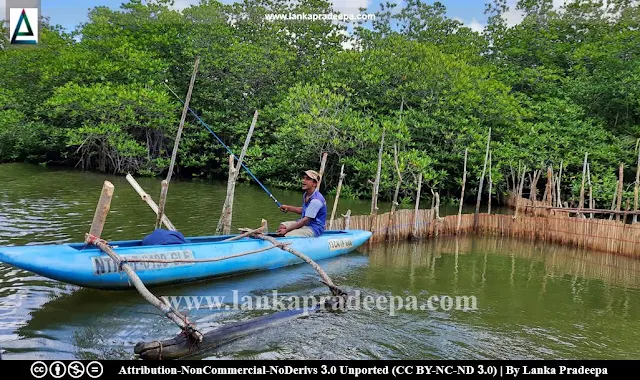
The Madu-Ganga Wetland, or Maduganga Mangrove Estuary (Sinhala: මාදු ගඟ), is a small and relatively shallow brackish coastal aquatic system situated in the Galle District, Sri Lanka. Due to the high biodiversity and ecological values it possesses, Madu-Ganga was declared a Ramsar Convention site in 2003, and the Department of Wildlife Conservation, Sri Lanka named it a Sanctuary in 2006 (Alagan & Aladuwaka, 2014; Marasinghe et al., 2021; Ratnayake et al., 2017). Presently, the area is popular as a nature-based tourist destination.
Location

The Madu-Ganga Wetland belongs to two Divisional Secretariats namely, Balapitiya and Karandeniya of Galle Districts (Bambaradeniya et al., 2002). It falls within the South-Western Lowland Wet Zone of Sri Lanka and hence experiences a perennially wet climate (Bambaradeniya et al., 2002). The average annual temperature of the area is around 27ºC, and the average annual precipitation is around 2500 mm (Ratnayake et al., 2017).
Formation
The wetland is formed of two shallow water bodies: (1) Madu Ganga, which is the primary water body, and (2) the Randombe Lake, which is relatively smaller than Madu Ganga (Alagan & Aladuwaka, 2014). The central basin of the wetland is mainly fed by three tributary rivers; Boralessa Ela, Heen Ela, and Magala Ela (Bambaradeniya et al., 2002). The wetland extends in an area of about 915 ha, of which 770 ha consists of open water (Bambaradeniya et al., 2002; Marasinghe et al., 2021). A total of 15 islands (145 ha of total land area) are surrounded by water throughout the year (Bambaradeniya et al., 2002; Marasinghe et al., 2021). The wetland is opened to the Indian Ocean by a narrow and short entrance channel (Ratnayake et al., 2017). Periodic geomorphological changes are observable at this channel throughout the year (Ratnayake et al., 2017).
Flora & Fauna
Madu-Ganga has a rich biodiversity. The wetland consists of 303 species of plants belonging to 95 families (Amarathunga et al., 2010; Ratnayake et al., 2017). The total plant species comprise 19 endemics, 8 nationally threatened species, and 9 invasive alien species (Amarathunga et al., 2010; Ratnayake et al., 2017). Local vegetation of the wetland is dominated by mangrove swamps (Ratnayake et al., 2017). Thick mangrove vegetation is found along the northern and northwestern banks of Madu-Ganga, at the lagoon mouth, and on a majority of the islands (Bambaradeniya et al., 2002).
A total of 248 species of vertebrate fauna, belonging to 121 families have been recorded from Maduganga (Amarathunga et al., 2010; Bambaradeniya et al., 2002). These included 20 species of endemics, while 30 species are nationally threatened (Amarathunga et al., 2010; Bambaradeniya et al., 2002). The wetland supports over 111 bird species, including 13 migratory species (Marasinghe et al., 2021).



.
See also
#) Rivers of Sri Lanka
References
1) Alagan, R. and Aladuwaka, S., 2014. Participatory geographic information systems for environmental zoning plan: Case Study of the Madu Ganga estuary, Sri Lanka. In Voices of Globalization. Emerald Group Publishing Limited. pp.217-232.
2) Amarathunga, A.A.D., Sureshkumar, N., Weerasekara, K.A.W.S., Wickramaarachchi, W.D.N. and Azmy, S.A.M., 2010. Study the effect of salinity and nutrients for the growth of Najas marina and its impact to aquatic biodiversity in Madu Ganga Ramsar Wetland in Sri Lanka. In Proceedings of International Forestry and Environment Symposium (Vol. 15).
3) Bambaradeniya, C.N., Ekanayake, S.P., Kekulandala, L.D.C.B., Fernando, R.H.S.S., Samarawickrama, V.A.P. and Priyadharshana, T.G.M., 2002. An assessment of the status of biodiversity in the Maduganga mangrove estuary. Occasional Papers of IUCN Sri Lanka, 1, p.1.
4) Marasinghe, S., Perera, P., Simpson, G.D. and Newsome, D., 2021. Nature-based tourism development in coastal wetlands of Sri Lanka: An Importance–Performance analysis at Maduganga Mangrove Estuary. Journal of Outdoor Recreation and Tourism, 33, pp.1-12.
5) Ratnayake, A.S., Dushyantha, N., De Silva, N., Somasiri, H.P., Jayasekara, N.N., Weththasinghe, S.M., Samaradivakara, G.V.I., Vijitha, A.V.P. and Ratnayake, N.P., 2017. Sediment and physicochemical characteristics in Madu-ganga Estuary, southwest Sri Lanka. J Geol Soc Sri Lanka, 18, pp.43-52.
2) Amarathunga, A.A.D., Sureshkumar, N., Weerasekara, K.A.W.S., Wickramaarachchi, W.D.N. and Azmy, S.A.M., 2010. Study the effect of salinity and nutrients for the growth of Najas marina and its impact to aquatic biodiversity in Madu Ganga Ramsar Wetland in Sri Lanka. In Proceedings of International Forestry and Environment Symposium (Vol. 15).
3) Bambaradeniya, C.N., Ekanayake, S.P., Kekulandala, L.D.C.B., Fernando, R.H.S.S., Samarawickrama, V.A.P. and Priyadharshana, T.G.M., 2002. An assessment of the status of biodiversity in the Maduganga mangrove estuary. Occasional Papers of IUCN Sri Lanka, 1, p.1.
4) Marasinghe, S., Perera, P., Simpson, G.D. and Newsome, D., 2021. Nature-based tourism development in coastal wetlands of Sri Lanka: An Importance–Performance analysis at Maduganga Mangrove Estuary. Journal of Outdoor Recreation and Tourism, 33, pp.1-12.
5) Ratnayake, A.S., Dushyantha, N., De Silva, N., Somasiri, H.P., Jayasekara, N.N., Weththasinghe, S.M., Samaradivakara, G.V.I., Vijitha, A.V.P. and Ratnayake, N.P., 2017. Sediment and physicochemical characteristics in Madu-ganga Estuary, southwest Sri Lanka. J Geol Soc Sri Lanka, 18, pp.43-52.
Location Map
This page was last updated on 9 April 2023

